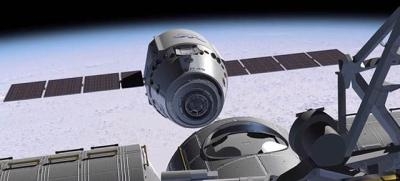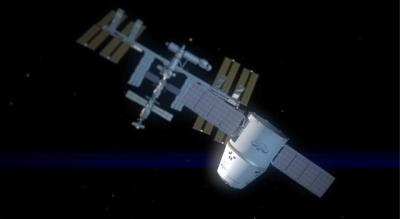Thu, May 24, 2012
Fifteen Experiments Focusing On Physical, Chemical, And Biological Systems
The SpaceX Dragon capsule, which on Tuesday became the first commercially developed and built spacecraft to launch to the International Space Station, is carrying among its cargo a suite of 15 science experiments designed by students.

Known collectively as Aquarius, the experiments will assess the effects of microgravity on physical, chemical and biological systems. The students have been immersed in every facet of research, from definition of the investigation to experiment design, proposal writing and a formal NASA proposal review for selection of flight experiments. "This unique student activity adds a new dimension to the International Space Station and its role as America's only orbiting national laboratory," said Leland Melvin, NASA's associate administrator for Education. "It also clearly demonstrates that students still can actively participate in NASA microgravity opportunities in the post-shuttle era."
Aquarius is sponsored by the Student Space Flight Experiments Program (SSEP), which is a cooperative venture by the National Center for Earth and Space Science Education (NCESSE) and NanoRacks LLC, a national science, technology, engineering and mathematics (STEM) education initiative. The organizations work together to give 300 to 1,000 students across a community the opportunity to design and propose microgravity experiments to fly in low Earth orbit.
The first two SSEP payloads flew in 2011 aboard space shuttles Endeavour and Atlantis on the STS-134 and STS-135 missions respectively. This third round of experiments will be the first to be conducted in orbit by space station astronauts. The announcement of opportunity for Aquarius was released in July 2011. It elicited responses from 12 communities in nine states and the District of Columbia. A total of 779 student teams, with 41,200 members ranging from fifth graders to community college, submitted proposals. After a formal two-step review process in fall 2011, the final 15 flight experiments were selected. They all passed a formal NASA flight safety review, clearing the final hurdle on their journey to launch.
This is one of many programs that use NASA's science and exploration missions to encourage students to pursue a STEM-centric school curriculum. Building a robust cadre of scientists and engineers for the future is a high priority for NASA's Office of Education. (Images provided by SpaceX)

More News
Also: Pratt & Whitney 747SP, Gratia Aero, Robinson/MagniX, Jack Pelton Part5 The Avidyne Vantage 12 is finally certified and will shortly be shipping out so that aging Cirrus a>[...]
Aero Linx: Army Aviation Medicine Association (AAVMA) The Society of US Army Flight Surgeons (SoUSAFS) serves to advance the science and art of Aerospace Medicine and its allied sc>[...]
Witnesses Reported That They Heard A Loss Of Engine Power Analysis: Witnesses reported that the airplane departed from runway 35 after a successful runup. During the initial climb,>[...]
Radio Magnetic Indicator An aircraft navigational instrument coupled with a gyro compass or similar compass that indicates the direction of a selected NAVAID and indicates bearing >[...]
"After exiting, I had a vague recollection of what just happened…and a much clearer view of how quickly hypoxia can sneak up. Sign-ups for PROTE are open each day of AirVent>[...]
 OSH25 Day 5 Redux: Avidyne Vantage 12, Is Fly-Inn An AeroBnB?, B25 Miss Mitchell
OSH25 Day 5 Redux: Avidyne Vantage 12, Is Fly-Inn An AeroBnB?, B25 Miss Mitchell ANN's Daily Aero-Linx (07.29.25)
ANN's Daily Aero-Linx (07.29.25) NTSB Final Report: Curtiss Wright P-40E
NTSB Final Report: Curtiss Wright P-40E ANN's Daily Aero-Term (07.29.25): Radio Magnetic Indicator
ANN's Daily Aero-Term (07.29.25): Radio Magnetic Indicator Aero-News: Quote of the Day (07.29.25)
Aero-News: Quote of the Day (07.29.25)




